Paper Menu >>
Journal Menu >>
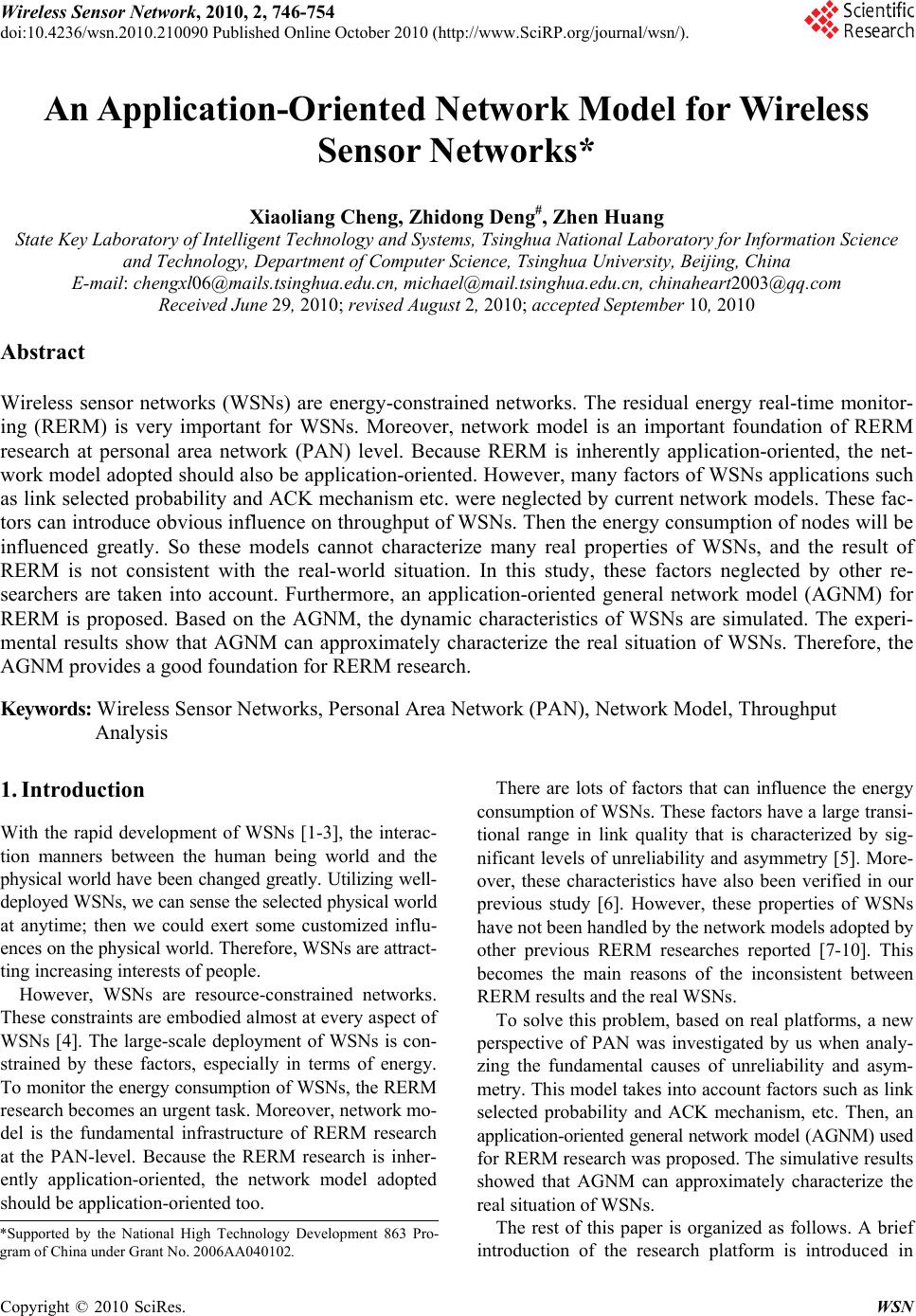 Wireless Sensor Network, 2010, 2, 746-754 doi:10.4236/wsn.2010.210090 October 2010 (http://www.SciRP.org/journal/wsn/). Copyright © 2010 SciRes. WSN Published Online An Application-Oriented Network Model for Wireless Sensor Networks* Xiaoliang Cheng, Zhidong Deng#, Zhen Huang State Key Laboratory of Intelligent Technology and Systems, Tsinghua National Laboratory for Information Science and Technology, Department of Computer Science, Tsinghua University, Beijing, China E-mail: chengxl06@mails.tsinghua.edu.cn, michael@mail.tsinghua.edu.cn, chinaheart2003 @qq.com Received June 29, 2010; revised August 2, 2010; accepted September 10, 2010 Abstract Wireless sensor networks (WSNs) are energy-constrained networks. The residual energy real-time monitor- ing (RERM) is very important for WSNs. Moreover, network model is an important foundation of RERM research at personal area network (PAN) level. Because RERM is inherently application-oriented, the net- work model adopted should also be application-oriented. However, many factors of WSNs applications such as link selected probability and ACK mechanism etc. were neglected by current network models. These fac- tors can introduce obvious influence on throughput of WSNs. Then the energy consumption of nodes will be influenced greatly. So these models cannot characterize many real properties of WSNs, and the result of RERM is not consistent with the real-world situation. In this study, these factors neglected by other re- searchers are taken into account. Furthermore, an application-oriented general network model (AGNM) for RERM is proposed. Based on the AGNM, the dynamic characteristics of WSNs are simulated. The experi- mental results show that AGNM can approximately characterize the real situation of WSNs. Therefore, the AGNM provides a good foundation for RERM research. Keywords: Wireless Sensor Networks, Personal Area Network (PAN), Network Model, Throughput Analysis 1. Introduction With the rapid development of WSNs [1-3], the interac- tion manners between the human being world and the physical world have been changed greatly. Utilizing well- deployed WSNs, we can sense the selected physical world at anytime; then we could exert some customized influ- ences on the physical world. Therefore, WSNs are attract- ting increasing interests of people. However, WSNs are resource-constrained networks. These constraints are embodied almost at every aspect of WSNs [4]. The large-scale deployment of WSNs is con- strained by these factors, especially in terms of energy. To monitor the energy consumption of WSNs, the RERM research becomes an urgent task. Moreover, network mo- del is the fundamental infrastructure of RERM research at the PAN-level. Because the RERM research is inher- ently application-oriented, the network model adopted should be application-oriented too. There are lots of factors that can influence the energy consumption of WSNs. These factors have a large transi- tional range in link quality that is characterized by sig- nificant levels of unreliability and asymmetry [5]. More- over, these characteristics have also been verified in our previous study [6]. However, these properties of WSNs have not been handled by the network models adopted by other previous RERM researches reported [7-10]. This becomes the main reasons of the inconsistent between RERM results and the real WSNs. To solve this problem, based on real platforms, a new perspective of PAN was investigated by us when analy- zing the fundamental causes of unreliability and asym- metry. This model takes into account factors such as link selected probability and ACK mechanism, etc. Then, an application-oriented general network model (AGNM) used for RERM research was proposed. The simulative results showed that AGNM can approximately characterize the real situation of WSNs. The rest of this paper is organized as follows. A brief introduction of the research platform is introduced in *Supported by the National High Technology Development 863 Pro- gram of China under Grant No. 2006AA040102.  X. L. CHENG ET AL.747 Section 2. AGNM is proposed in Section 3. In Section 4, some simulation experiments are carried out to testify the effectiveness of AGNM. Section 5 concludes this paper and suggests some future research topics. 2. Research Platform The RERM research should be application-oriented. To effectively study RERM, an application-oriented general network model for WSNs (AGNM) should be proposed first. The AGNM model should be established based on appropriate platform and real application environment. To our best knowledge, the ZigBee/802.15.4 specifica- tion reflects the basic characteristics of WSNs better than other specifications [4,11]. The BeeStack protocol stack is complied with ZigBee/802.15.4 [12]. So, the ZigBee/ 802.15.4 and BeeStack protocols are selected as our re- search platforms. ZigBee [13] is based on 802.15.4 [14]. The medium access control (MAC) layer and physical layer (PHY) were defined by 802.15.4; and the upper layers from network layer (NWK) were defined by ZigBee. Espe- cially, the NWK layer of ZigBee provides full support for Star, Cluster-Tree and Mesh topologies. In the ZigBee specification, nodes are categorized into three types: coordinator (ZC), router (ZR) and end device (ZED). ZC creates and maintains a PAN. ZRs route data to ZC and help maintaining a PAN. ZEDs sense the phy- sical world and send information to ZC with the help of ZRs. Moreover, each node maintains a neighbor table locally. After the node has joined a PAN, its neighbor table will be used to store relationship and link-state in- formation about neighbor nodes. The table entry of a node should be updated when any frame is received from its neighbors. Based on this platform, some assumptions can be drawn out. Then, an application-oriented network model can be established. 3. Application-Oriented General Network Model If all the nodes have good consistency, then the energy consumption of each node is mainly determined by its throughputs. Moreover, the throughput is influenced by many other factors. From a perspective of a PAN, these factors can be categorized into two classes: PAN-outside factors (electromagnetic environment etc.), PAN-inside factors (topology, ACK mechanism etc.). For simplicity, only the PAN-inside factors are dis- cussed here. The PAN-inside factors can be subdivided into two subclasses: the topology factors and the opera- tional factors. Both of them are dynamic and uncertain, especially in the case of Mesh topology. 3.1. Modeling of Topology Factors All the monitoring frameworks proposed in [7-10] can- not provide any support for Mesh topology. Moreover, they cannot be used for the mobile nodes. Hence, their scalability decreased greatly. To solve these problems, this subsection will propose a dynamic topology model based the analysis of ZigBee Mesh topology. 1) Analysis of ZigBee Mesh Topology: A typical Zig- Bee Mesh topology was introduced as Figure 1. In Figure 1, dark circle denotes ZC node; gray cir- cles denote ZR nodes; white circles denote ZED nodes. Lines denote bidirectional radio links. Especially, links among node-1, 2, 3 and 4 form a typical mesh structure. Note that a path loop among nodes should be forbidden, i.e., a frame should not pass through the same node more than once in a delivery path. Let the length of path from nodeto ZC bei, and the minimum hops from node to ZC be, then we adopt the follow- ing constraint: iL 1D ii D ii i DL . In Figure 2, the paths of query-message are depicted by downward arrow lines that start from node-1 (ZC). The relationships among neighbor nodes are created during topology formation. In ZigBee, there are three relationship types: parent, child and sibling. Here, a parent emits a unidirectional arrow line; a child is in- jected by a unidirectional arrow line; siblings are con- nected by bidirectional arrow line, because sibling is a mutual relationship type. For convenience, some addi- tional relationship types are defined by us. Figure 1. A typical ZigBee Mesh topology. Figure 2. Topology-construction and message-query in Zig- Bee Mesh topology (downlinks). Copyright © 2010 SciRes. WSN 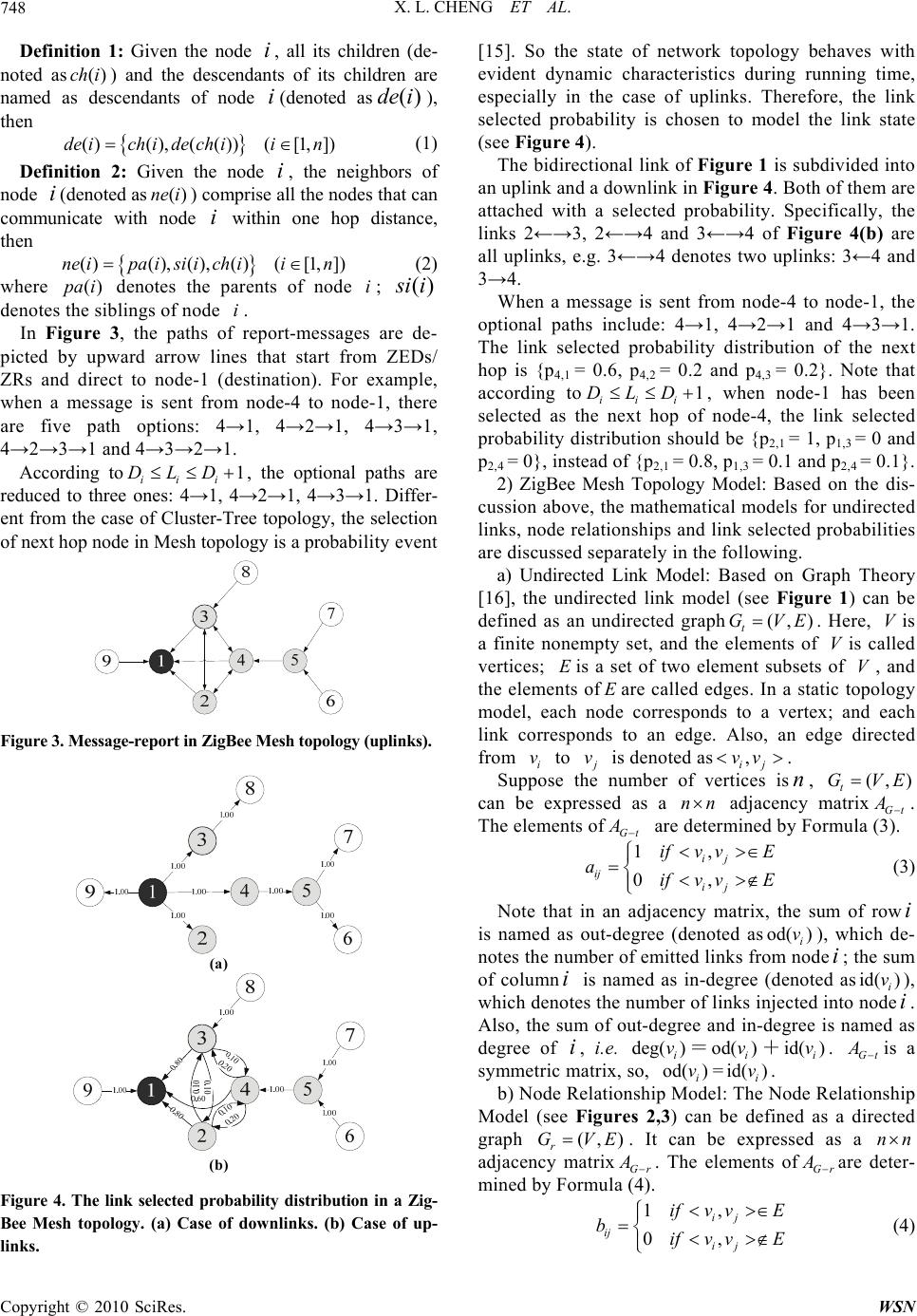 X. L. CHENG ET AL. Copyright © 2010 SciRes. WSN 748 Definition 1: Given the node , all its children (de- noted as) and the descendants of its children are named as descendants of node i(denoted as), then i ()ch i )(ide ()(),(())([1, ])de ich ide ch iin i (1) Definition 2: Given the node , the neighbors of node (denoted as) comprise all the nodes that can communicate with node within one hop distance, then i()ne i i ()(),(),()([1,])ne ipa isi ich iin ()pai (2) where denotes the parents of node i; denotes the siblings of node . )(isi i In Figure 3, the paths of report-messages are de- picted by upward arrow lines that start from ZEDs/ ZRs and direct to node-1 (destination). For example, when a message is sent from node-4 to node-1, there are five path options: 4→1, 4→2→1, 4→3→1, 4→2→3→1 and 4→3→2→1. According to, the optional paths are reduced to three ones: 4→1, 4→2→1, 4→3→1. Differ- ent from the case of Cluster-Tree topology, the selection of next hop node in Mesh topology is a probability event 1 ii i DLD Figure 3. Message-report in ZigBee Mesh topology (uplinks). (a) (b) Figure 4. The link selected probability distribution in a Zig- Bee Mesh topology. (a) Case of downlinks. (b) Case of up- links. [15]. So the state of network topology behaves with evident dynamic characteristics during running time, especially in the case of uplinks. Therefore, the link selected probability is chosen to model the link state (see Figure 4). The bidirectional link of Figure 1 is subdivided into an uplink and a downlink in Figure 4. Both of them are attached with a selected probability. Specifically, the links 2←→3, 2←→4 and 3←→4 of Figure 4(b) are all uplinks, e.g. 3←→4 denotes two uplinks: 3←4 and 3→4. When a message is sent from node-4 to node-1, the optional paths include: 4→1, 4→2→1 and 4→3→1. The link selected probability distribution of the next hop is {p4,1 = 0.6, p4,2 = 0.2 and p4,3 = 0.2}. Note that according to1 ii i DLD , when node-1 has been selected as the next hop of node-4, the link selected probability distribution should be {p2,1 = 1, p1,3 = 0 and p2,4 = 0}, instead of {p2,1 = 0.8, p1,3 = 0.1 and p2,4 = 0.1}. 2) ZigBee Mesh Topology Model: Based on the dis- cussion above, the mathematical models for undirected links, node relationships and link selected probabilities are discussed separately in the following. a) Undirected Link Model: Based on Graph Theory [16], the undirected link model (see Figure 1) can be defined as an undirected graph. Here, is a finite nonempty set, and the elements of is called vertices; is a set of two element subsets of , and the elements ofare called edges. In a static topology model, each node corresponds to a vertex; and each link corresponds to an edge. Also, an edge directed from to (, ) t GVEV V EV E i v j v is denoted as. , ij vv n Suppose the number of vertices is, (, ) tEGV can be expressed as a adjacency matrixGt nn A . The elements ofGt A are determined by Formula (3). 1, 0, ij ij ij ifv vE aifvvE (3) Note that in an adjacency matrix, the sum of row is named as out-degree (denoted as), which de- notes the number of emitted links from nodei; the sum of columni is named as in-degree (denoted asi), which denotes the number of links injected into nodei. Also, the sum of out-degree and in-degree is named as degree of , i.e. =+. i ) od( ) i v id( ) i v id(v Gt ideg( ) i vod() i v A is a symmetric matrix, so, =. od(v)id(v i i b) Node Relationship Model: The Node Relationship Model (see Figures 2,3) can be defined as a directed graph ) (, ) r GVE . It can be expressed as a nn adjacency matrixGr A . The elements ofGr A are deter- mined by Formula (4). 1, 0, ij ij ij ifv vE bifv vE (4) 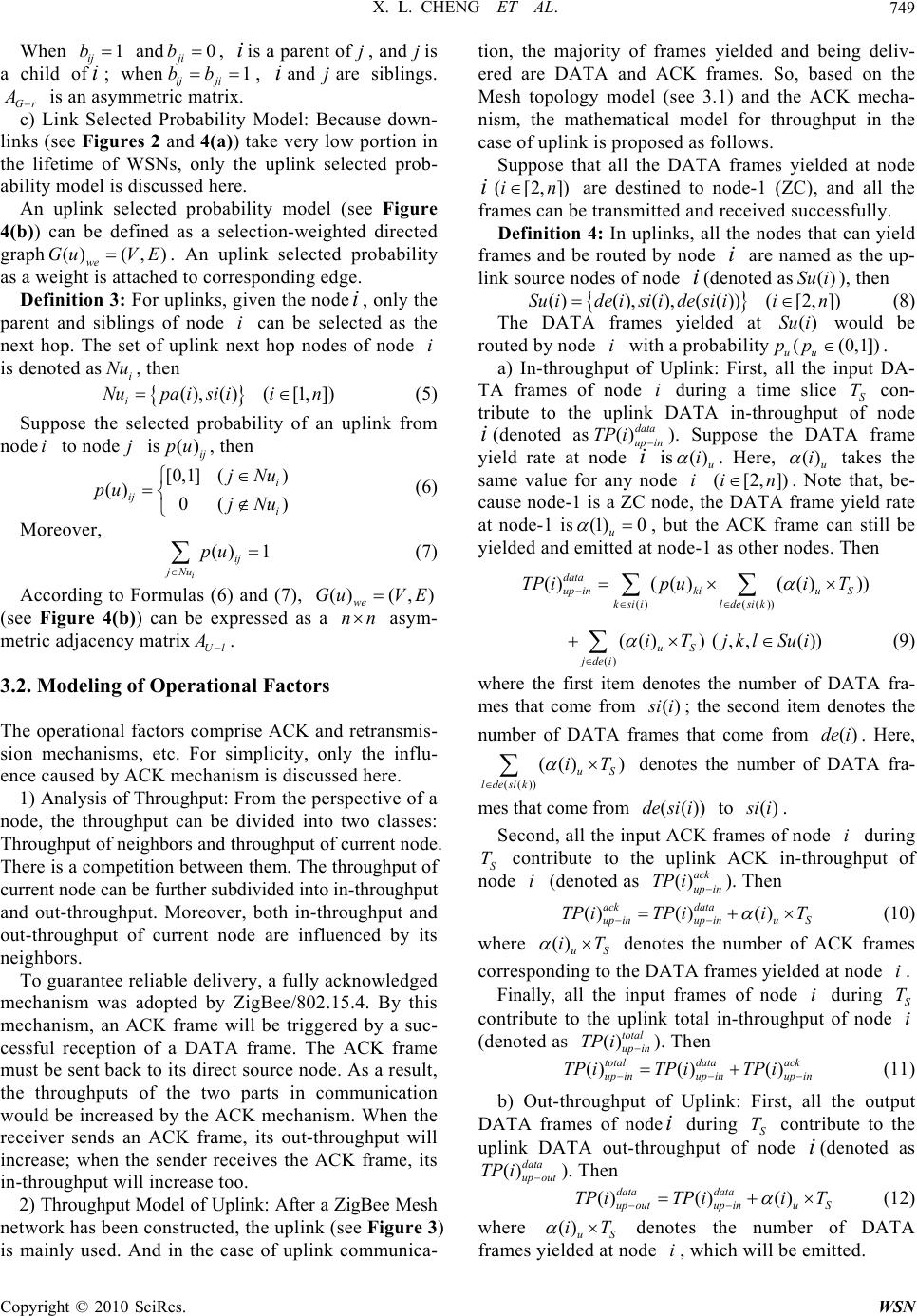 X. L. CHENG ET AL.749 When and, is a parent of, andis a child of; whenij ji, and are siblings. 1 ij b i 0 ji b bb i 1 j j ij Gr A is an asymmetric matrix. c) Link Selected Probability Model: Because down- links (see Figures 2 and 4(a)) take very low portion in the lifetime of WSNs, only the uplink selected prob- ability model is discussed here. An uplink selected probability model (see Figure 4(b)) can be defined as a selection-weighted directed graph . An uplink selected probability as a weight is attached to corresponding edge. ()( ,) we GuV E Definition 3: For uplinks, given the node, only the parent and siblings of node can be selected as the next hop. The set of uplink next hop nodes of node is denoted as, then i i i i Nu (),()([1, ]) i Nupa isi iin ) (5) Suppose the selected probability of an uplink from node to node is, then ij()ij pu [0,1] () () 0( i ij i jNu pu jNu (6) Moreover, () 1 i ij jNu pu (7) According to Formulas (6) and (7), ()( ,) we GuV E (see Figure 4(b)) can be expressed as a asym- metric adjacency matrix nn Ul A . 3.2. Modeling of Operational Factors The operational factors comprise ACK and retransmis- sion mechanisms, etc. For simplicity, only the influ- ence caused by ACK mechanism is discussed here. 1) Analysis of Throughput: From the perspective of a node, the throughput can be divided into two classes: Throughput of neighbors and throughput of current node. There is a competition between them. The throughput of current node can be further subdivided into in-throughput and out-throughput. Moreover, both in-throughput and out-throughput of current node are influenced by its neighbors. To guarantee reliable delivery, a fully acknowledged mechanism was adopted by ZigBee/802.15.4. By this mechanism, an ACK frame will be triggered by a suc- cessful reception of a DATA frame. The ACK frame must be sent back to its direct source node. As a result, the throughputs of the two parts in communication would be increased by the ACK mechanism. When the receiver sends an ACK frame, its out-throughput will increase; when the sender receives the ACK frame, its in-throughput will increase too. 2) Throughput Model of Uplink: After a ZigBee Mesh network has been constructed, the uplink (see Figure 3) is mainly used. And in the case of uplink communica- tion, the majority of frames yielded and being deliv- ered are DATA and ACK frames. So, based on the Mesh topology model (see 3.1) and the ACK mecha- nism, the mathematical model for throughput in the case of uplink is proposed as follows. Suppose that all the DATA frames yielded at node i([2,])in are destined to node-1 (ZC), and all the frames can be transmitted and received successfully. Definition 4: In uplinks, all the nodes that can yield frames and be routed by node are named as the up- link source nodes of node (denoted as), then i i()Su i ())i()(), (),(Suide isiidii ()Su i ( e s[2, ])n (8) The DATA frames yielded at would be routed by node with a probability. i((0,1]) uu pp a) In-throughput of Uplink: First, all the input DA- TA frames of node during a time slice S T con- tribute to the uplink DATA in-throughput of node (denoted as i in i() data up TP i ). Suppose the DATA frame yield rate at node is i() u i . Here, () u i takes the same value for any node . Note that, be- cause node-1 is a ZC node, the DATA frame yield rate at node-1 is i([2,i])n (1) 0 u , but the ACK frame can still be yielded and emitted at node-1 as other nodes. Then ()(()) ()(( )(())) data up inkiuS ksii ldesik TP ip uiT () (() ) uS jdei iT (, ,())jkl Sui (9) where the first item denotes the number of DATA fra- mes that come from () s ii ; the second item denotes the number of DATA frames that come from . Here, ()de i (()) (() ) uS ldesik iT denotes the number of DATA fra- mes that come from to ((de si i)) () s ii . Second, all the input ACK frames of node during S contribute to the uplink ACK in-throughput of node (denoted as ). Then i T i() ack up in TP i data ()() () ack up inup inuS TP iTP iiT (10) where () uS iT denotes the number of ACK frames corresponding to the DATA frames yielded at node . i Finally, all the input frames of node during contribute to the uplink total in-throughput of node (denoted as iS T i () total up in TP i ). Then () total TP i() () data ack up inup inup in TP iTPi (11) b) Out-throughput of Uplink: First, all the output DATA frames of node during S T contribute to the uplink DATA out-throughput of node (denoted as ). Then i T i T () data up out TP i ()() () data data up outup inuS TP iP ii (12) where () uS iT denotes the number of DATA frames yielded at node , which will be emitted. i Copyright © 2010 SciRes. WSN 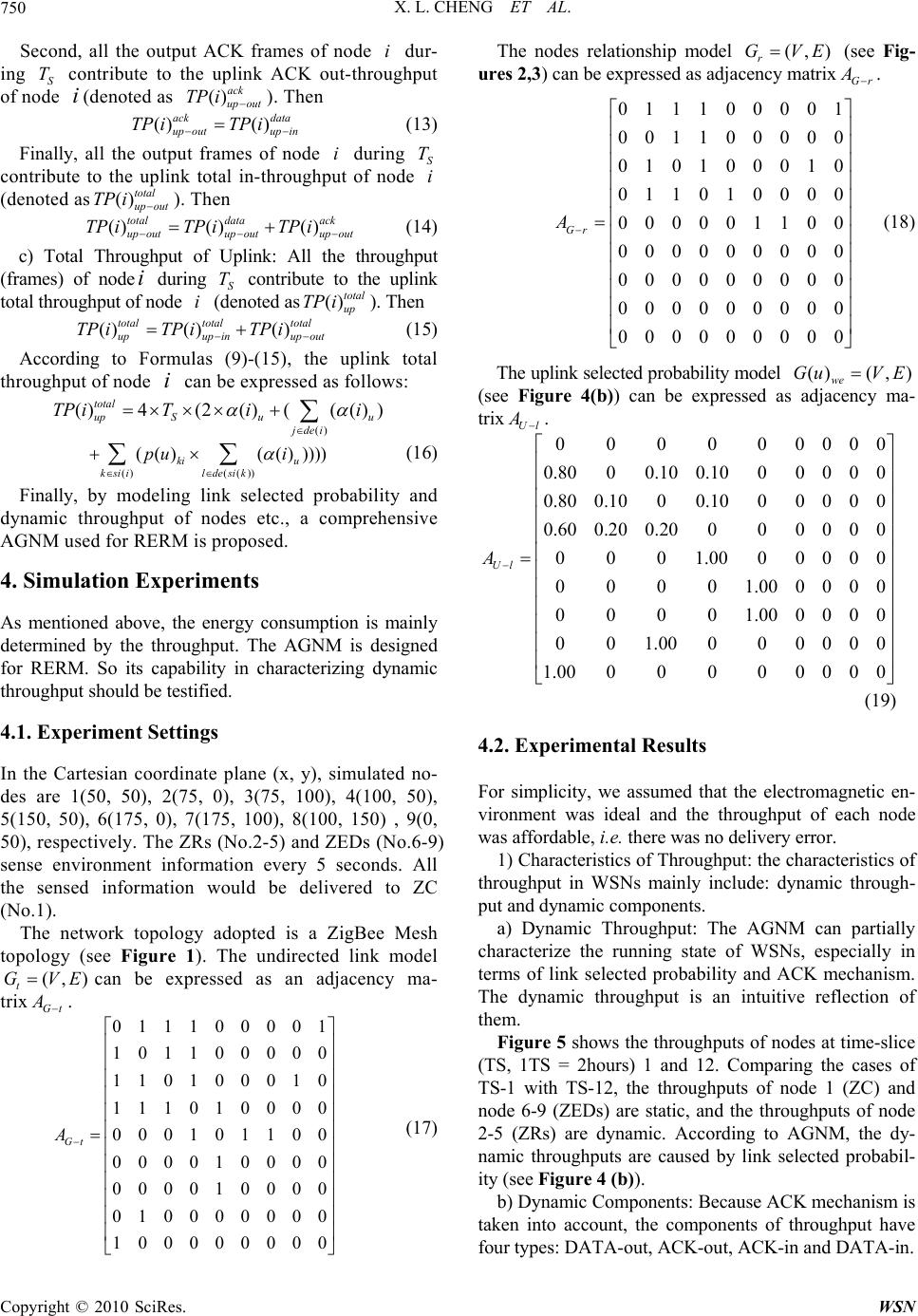 X. L. CHENG ET AL. Copyright © 2010 SciRes. WSN 750 Second, all the output ACK frames of node dur- ing S contribute to the uplink ACK out-throughput of node (denoted as ). Then i T i() ack up out TP i () ack TP i() data up outup in TP i (13) Finally, all the output frames of node during contribute to the uplink total in-throughput of node (denoted as). Then i ck S T i () total up out TP i () total TP i() () data a up outup outup out TP iTPi (14) c) Total Throughput of Uplink: All the throughput (frames) of node during S T contribute to the uplink total throughput of node (denoted as). Then i tal i () t i () total up TP i total () () to upup inup out TP iTPTP i otal (15) According to Formulas (9)-(15), the uplink total throughput of node can be expressed as follows: i () ()4(2()((() ) total up Suu jdei TP iTii ()(()) (()(( ))))) ki u ksii ldesik pu i (16) Finally, by modeling link selected probability and dynamic throughput of nodes etc., a comprehensive AGNM used for RERM is proposed. 4. Simulation Experiments As mentioned above, the energy consumption is mainly determined by the throughput. The AGNM is designed for RERM. So its capability in characterizing dynamic throughput should be testified. 4.1. Experiment Settings In the Cartesian coordinate plane (x, y), simulated no- des are 1(50, 50), 2(75, 0), 3(75, 100), 4(100, 50), 5(150, 50), 6(175, 0), 7(175, 100), 8(100, 150) , 9(0, 50), respectively. The ZRs (No.2-5) and ZEDs (No.6-9) sense environment information every 5 seconds. All the sensed information would be delivered to ZC (No.1). The network topology adopted is a ZigBee Mesh topology (see Figure 1). The undirected link model can be expressed as an adjacency ma- trix (, ) t GVE Gt A . 011100001 101100000 110100010 111010000 000101100 000010000 000010000 010000000 100000000 Gt A The nodes relationship model (see Fig- ures 2,3) can be expressed as adjacency matrix (, ) r GVE Gr A . 011100001 001100000 010100010 011010000 000001100 000000000 000000000 000000000 000000000 Gr A (18) The uplink selected probability model ()( ,) we GuV E (see Figure 4(b)) can be expressed as adjacency ma- trix Ul A . 0 0 0 000000 0.8000.100.100 0000 0.800.1000.100 0000 0.600.200.20 000000 000 1.00 0 0000 0 0 0 01.000000 0 0 0 01.000000 00 1.0000 0000 1.000 0 000000 Ul A (19) 4.2. Experimental Results For simplicity, we assumed that the electromagnetic en- vironment was ideal and the throughput of each node was affordable, i.e. there was no delivery error. 1) Characteristics of Throughput: the characteristics of throughput in WSNs mainly include: dynamic through- put and dynamic components. a) Dynamic Throughput: The AGNM can partially characterize the running state of WSNs, especially in terms of link selected probability and ACK mechanism. The dynamic throughput is an intuitive reflection of them. (17) Figure 5 shows the throughputs of nodes at time-slice (TS, 1TS = 2hours) 1 and 12. Comparing the cases of TS-1 with TS-12, the throughputs of node 1 (ZC) and node 6-9 (ZEDs) are static, and the throughputs of node 2-5 (ZRs) are dynamic. According to AGNM, the dy- namic throughputs are caused by link selected probabil- ity (see Figure 4 (b)). b) Dynamic Components: Because ACK mechanism is taken into account, the components of throughput have four types: DATA-out, ACK-out, ACK-in and DATA-in. 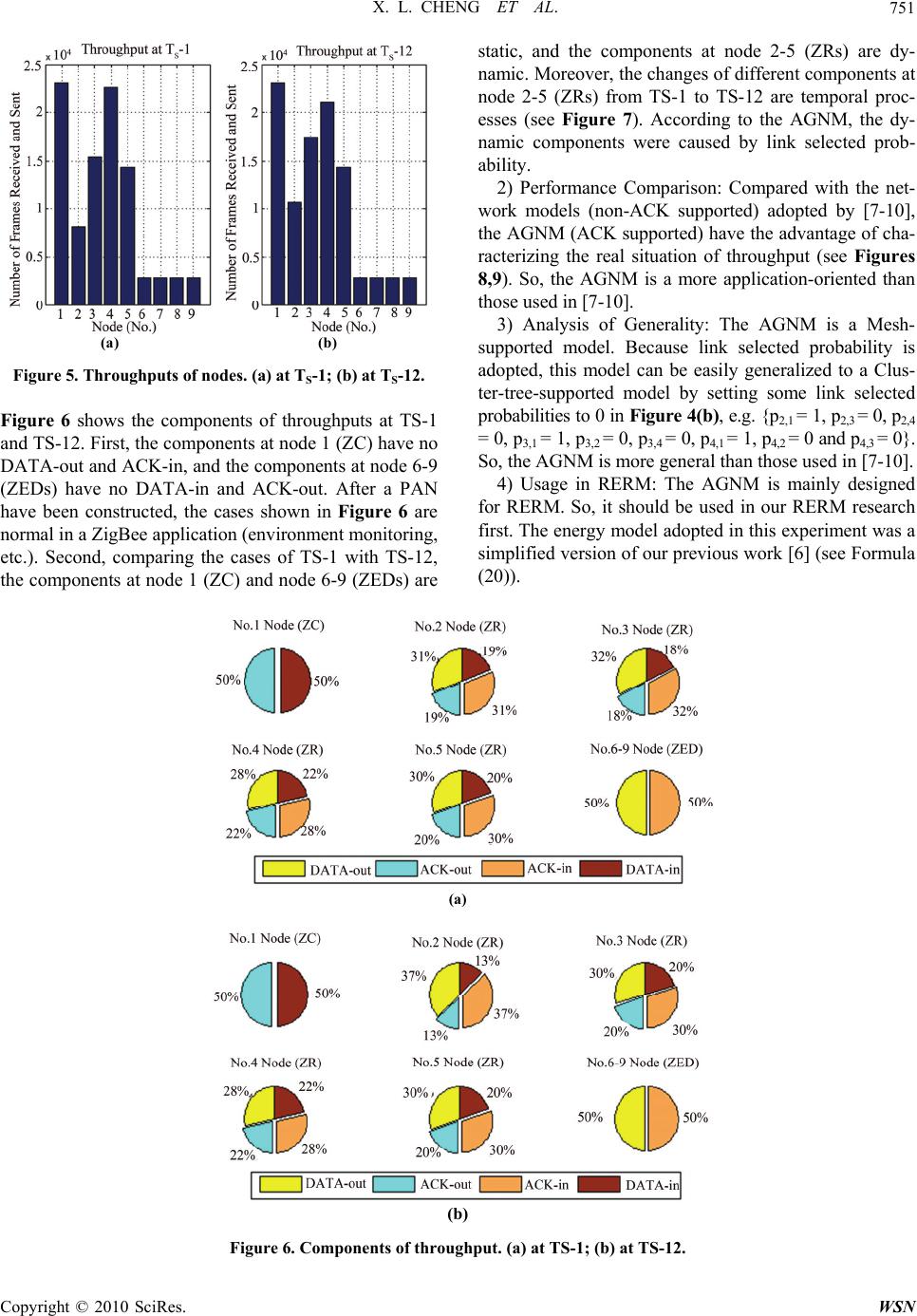 X. L. CHENG ET AL. Copyright © 2010 SciRes. WSN 751 static, and the components at node 2-5 (ZRs) are dy- namic. Moreover, the changes of different components at node 2-5 (ZRs) from TS-1 to TS-12 are temporal proc- esses (see Figure 7). According to the AGNM, the dy- namic components were caused by link selected prob- ability. 2) Performance Comparison: Compared with the net- work models (non-ACK supported) adopted by [7-10], the AGNM (ACK supported) have the advantage of cha- racterizing the real situation of throughput (see Figures 8,9). So, the AGNM is a more application-oriented than those used in [7-10]. 3) Analysis of Generality: The AGNM is a Mesh- supported model. Because link selected probability is adopted, this model can be easily generalized to a Clus- ter-tree-supported model by setting some link selected probabilities to 0 in Figure 4(b), e.g. {p2,1 = 1, p2,3 = 0, p2,4 = 0, p3,1 = 1, p3,2 = 0, p3,4 = 0, p4,1 = 1, p4,2 = 0 and p4,3 = 0}. So, the AGNM is more general than those used in [7-10]. ( a) (b) Figure 5. Throughputs of nodes. (a) at TS-1; (b) at TS-12. Figure 6 shows the components of throughputs at TS-1 and TS-12. First, the components at node 1 (ZC) have no DATA-out and ACK-in, and the components at node 6-9 (ZEDs) have no DATA-in and ACK-out. After a PAN have been constructed, the cases shown in Figure 6 are normal in a ZigBee application (environment monitoring, etc.). Second, comparing the cases of TS-1 with TS-12, the components at node 1 (ZC) and node 6-9 (ZEDs) are 4) Usage in RERM: The AGNM is mainly designed for RERM. So, it should be used in our RERM research first. The energy model adopted in this experiment was a simplified version of our previous work [6] (see Formula (20)). (a) (b) Figure 6. Components of throughput. (a) at TS-1; (b) at TS-12. 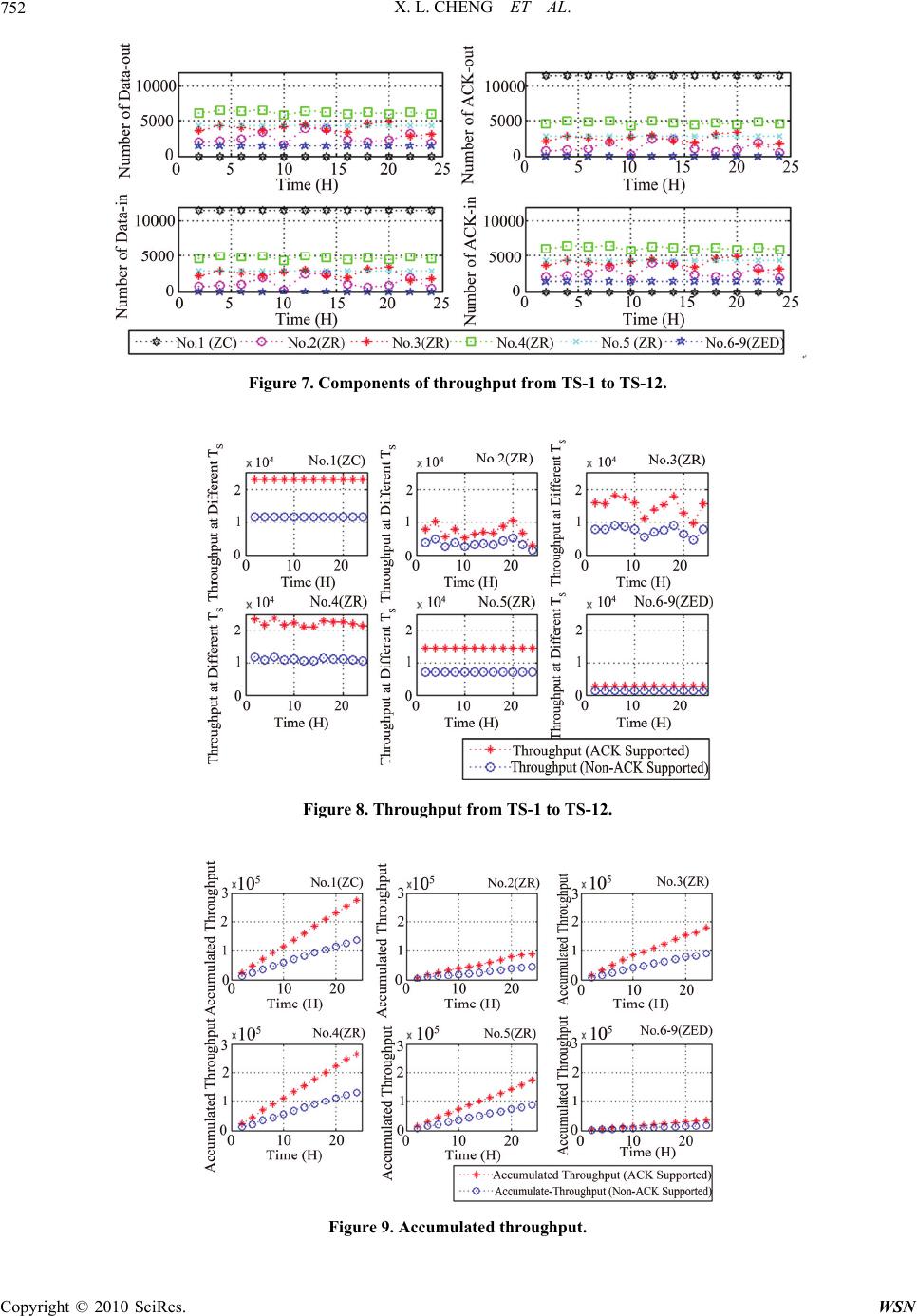 X. L. CHENG ET AL. Copyright © 2010 SciRes. WSN 752 Figure 7. Components of throughput from TS-1 to TS-12. Figure 8. Throughput from TS-1 to TS-12. Figure 9. Accumulated throughput. 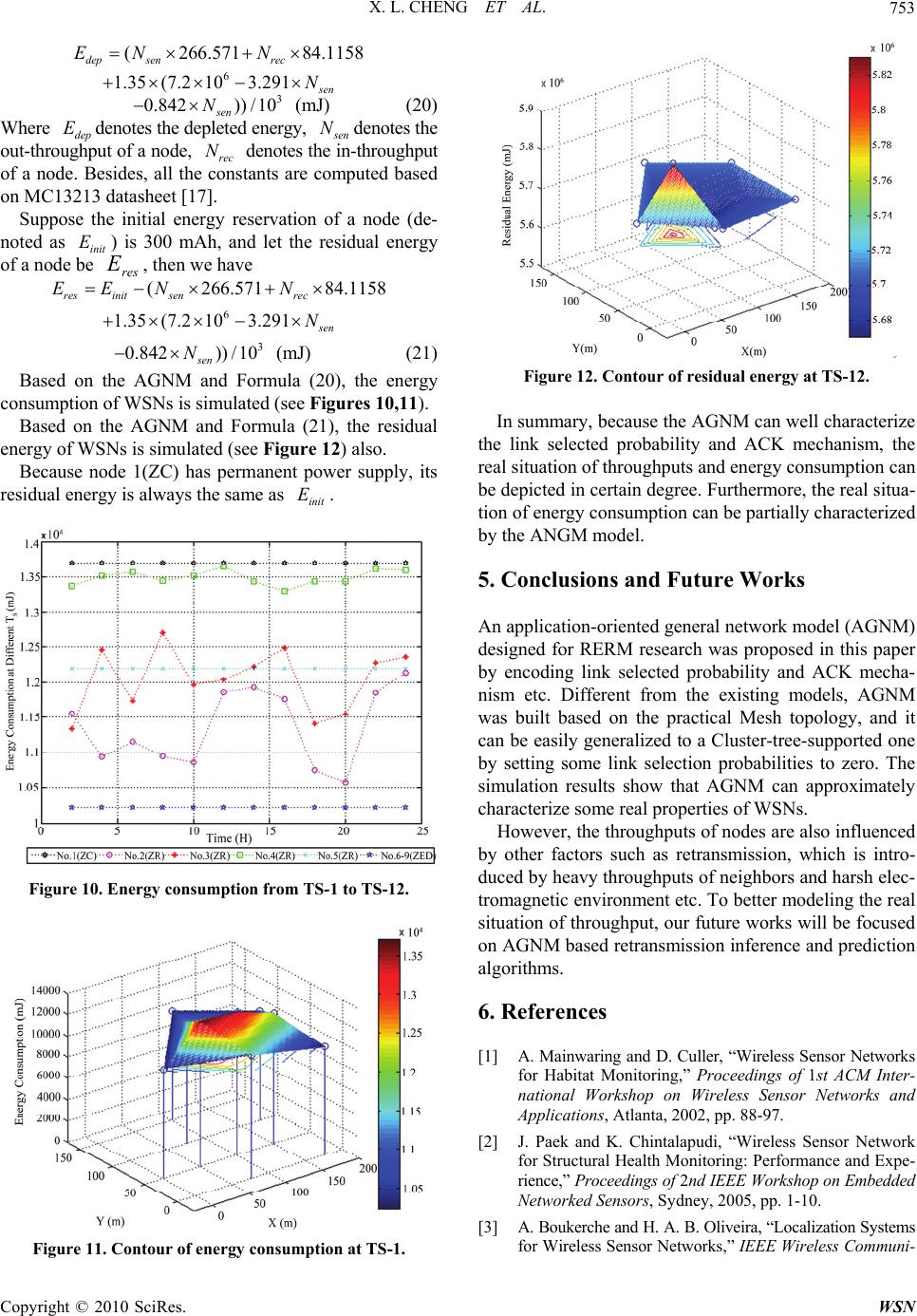 X. L. CHENG ET AL. 753 ( 266.57184.1158 dep senrec EN N 6 1.35(7.2 103.291 s en N 3 0.842)) /10N sen Where dep denotes the depleted energy, (mJ) (20) E s en denotes the out-throughput of a node, rec denotes the in-throughput of a node. Besides, all the constants are computed based on MC13213 datasheet [17]. N N Suppose the initial energy reservation of a node (de- noted as init ) is 300 mAh, and let the residual energy of a node be , then we have E E EE res ( 266.57184.1158 res initsenrec N N 6 1.35(7.2 103.291 s en N 3 0.842)) /10 sen N (mJ) (21) Based on the AGNM and Formula (20), the energy consumption of WSNs is simulated (see Figures 10,11). Based on the AGNM and Formula (21), the residual energy of WSNs is simulated (see Figure 12) also. Because node 1(ZC) has permanent power supply, its residual energy is always the same as . init E Figure 10. Energy consumption from TS-1 to TS-12. Figure 11. Contour of energy consumption at TS-1. Figure 12. Contour of residual energy at TS-12. In summary, because the AGNM can well characterize the link selected probability and ACK mechanism, the real situation of throughputs and energy consumption can be depicted in certain degree. Furthermore, the real situa- tion of energy consumption can be partially characterized by the ANGM model. 5. Conclusions and Future Works An application-oriented general network model (AGNM) designed for RERM research was proposed in this paper by encoding link selected probability and ACK mecha- nism etc. Different from the existing models, AGNM was built based on the practical Mesh topology, and it can be easily generalized to a Cluster-tree-supported one by setting some link selection probabilities to zero. The simulation results show that AGNM can approximately characterize some real properties of WSNs. However, the throughputs of nodes are also influenced by other factors such as retransmission, which is intro- duced by heavy throughputs of neighbors and harsh elec- tromagnetic environment etc. To better modeling the real situation of throughput, our future works will be focused on AGNM based retransmission inference and prediction algorithms. 6 . References [1] A. Mainwaring and D. Culler, “Wireless Sensor Networks for Habitat Monitoring,” Proceedings of 1st ACM Inter- national Workshop on Wireless Sensor Networks and Applications, Atlanta, 2002, pp. 88-97. [2] J. Paek and K. Chintalapudi, “Wireless Sensor Network for Structural Health Monitoring: Performance and Expe- rience,” Proceedings of 2nd IEEE Workshop on Embedded Networked Sensors, Sydney, 2005, pp. 1-10. [3] A. Boukerche and H. A. B. Oliveira, “Localization Systems for Wireless Sensor Networks,” IEEE Wireless Communi- C opyright © 2010 SciRes. WSN 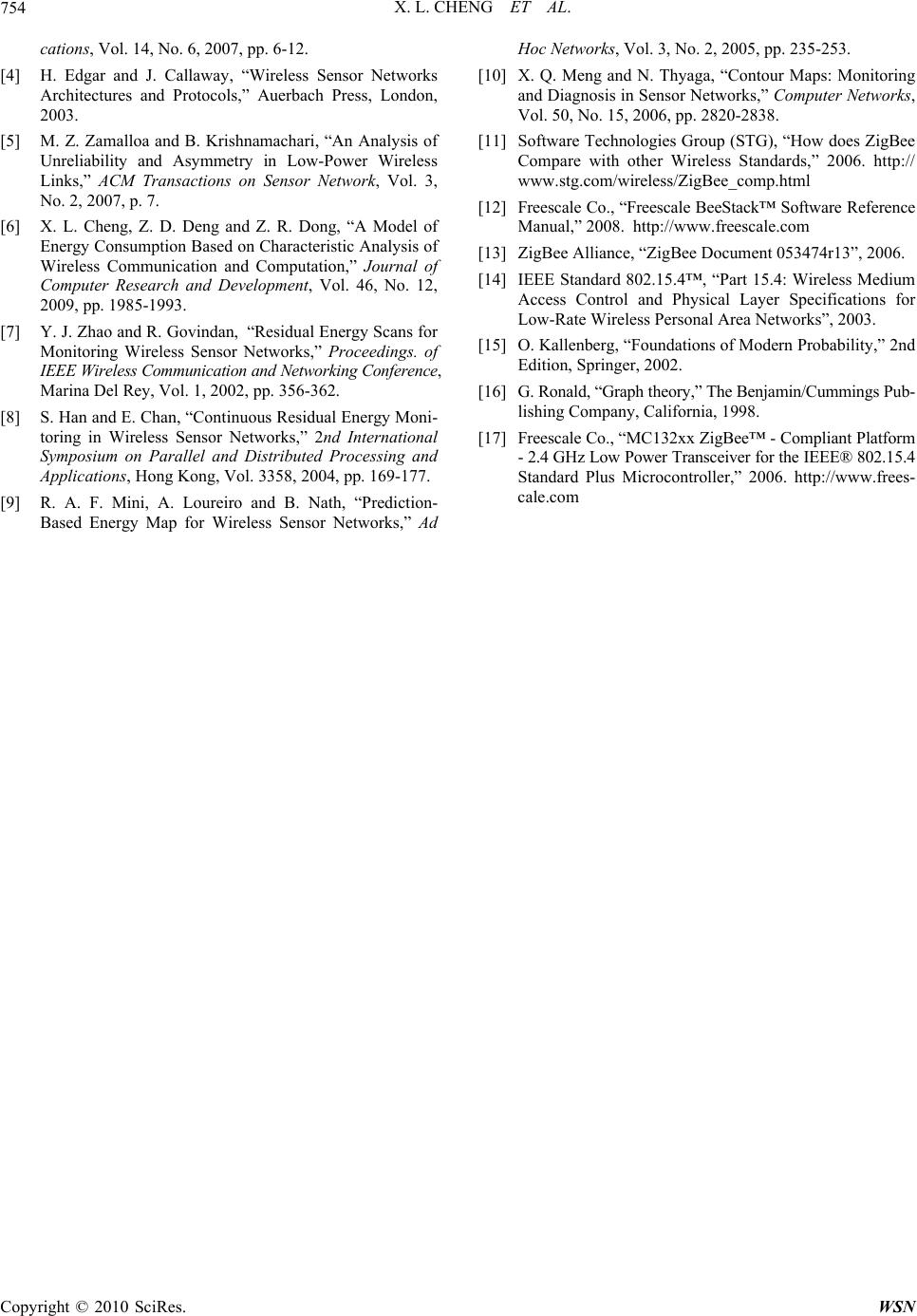 X. L. CHENG ET AL. Copyright © 2010 SciRes. WSN 754 cations, Vol. 14, No. 6, 2007, pp. 6-12. [4] H. Edgar and J. Callaway, “Wireless Sensor Networks Architectures and Protocols,” Auerbach Press, London, 2003. [5] M. Z. Zamalloa and B. Krishnamachari, “An Analysis of Unreliability and Asymmetry in Low-Power Wireless Links,” ACM Transactions on Sensor Network, Vol. 3, No. 2, 2007, p. 7. [6] X. L. Cheng, Z. D. Deng and Z. R. Dong, “A Model of Energy Consumption Based on Characteristic Analysis of Wireless Communication and Computation,” Journal of Computer Research and Development, Vol. 46, No. 12, 2009, pp. 1985-1993. [7] Y. J. Zhao and R. Govindan, “Residual Energy Scans for Monitoring Wireless Sensor Networks,” Proceedings. of IEEE Wireless Communication and Networking Conference, Marina Del Rey, Vol. 1, 2002, pp. 356-362. [8] S. Han and E. Chan, “Continuous Residual Energy Moni- toring in Wireless Sensor Networks,” 2nd International Symposium on Parallel and Distributed Processing and Applications, Hong Kong, Vol. 3358, 2004, pp. 169-177. [9] R. A. F. Mini, A. Loureiro and B. Nath, “Prediction- Based Energy Map for Wireless Sensor Networks,” Ad Hoc Networks, Vol. 3, No. 2, 2005, pp. 235-253. [10] X. Q. Meng and N. Thyaga, “Contour Maps: Monitoring and Diagnosis in Sensor Networks,” Computer Networks, Vol. 50, No. 15, 2006, pp. 2820-2838. [11] Software Technologies Group (STG), “How does ZigBee Compare with other Wireless Standards,” 2006. http:// www.stg.com/wireless/ZigBee_comp.html [12] Freescale Co., “Freescale BeeStack™ Software Reference Manual,” 2008. http://www.freescale.com [13] ZigBee Alliance, “ZigBee Document 053474r13”, 2006. [14] IEEE Standard 802.15.4™, “Part 15.4: Wireless Medium Access Control and Physical Layer Specifications for Low-Rate Wireless Personal Area Networks”, 2003. [15] O. Kallenberg, “Foundations of Modern Probability,” 2nd Edition, Springer, 2002. [16] G. Ronald, “Graph theory,” The Benjamin/Cummings Pub- lishing Company, California, 1998. [17] Freescale Co., “MC132xx ZigBee™ - Compliant Platform - 2.4 GHz Low Power Transceiver for the IEEE® 802.15.4 Standard Plus Microcontroller,” 2006. http://www.frees- cale.com |

